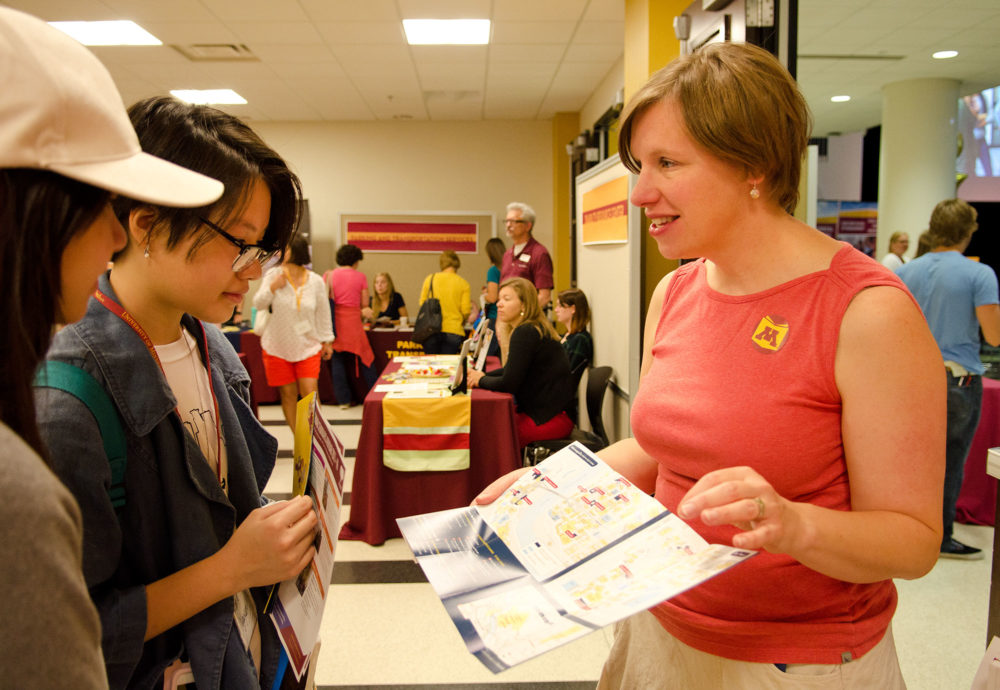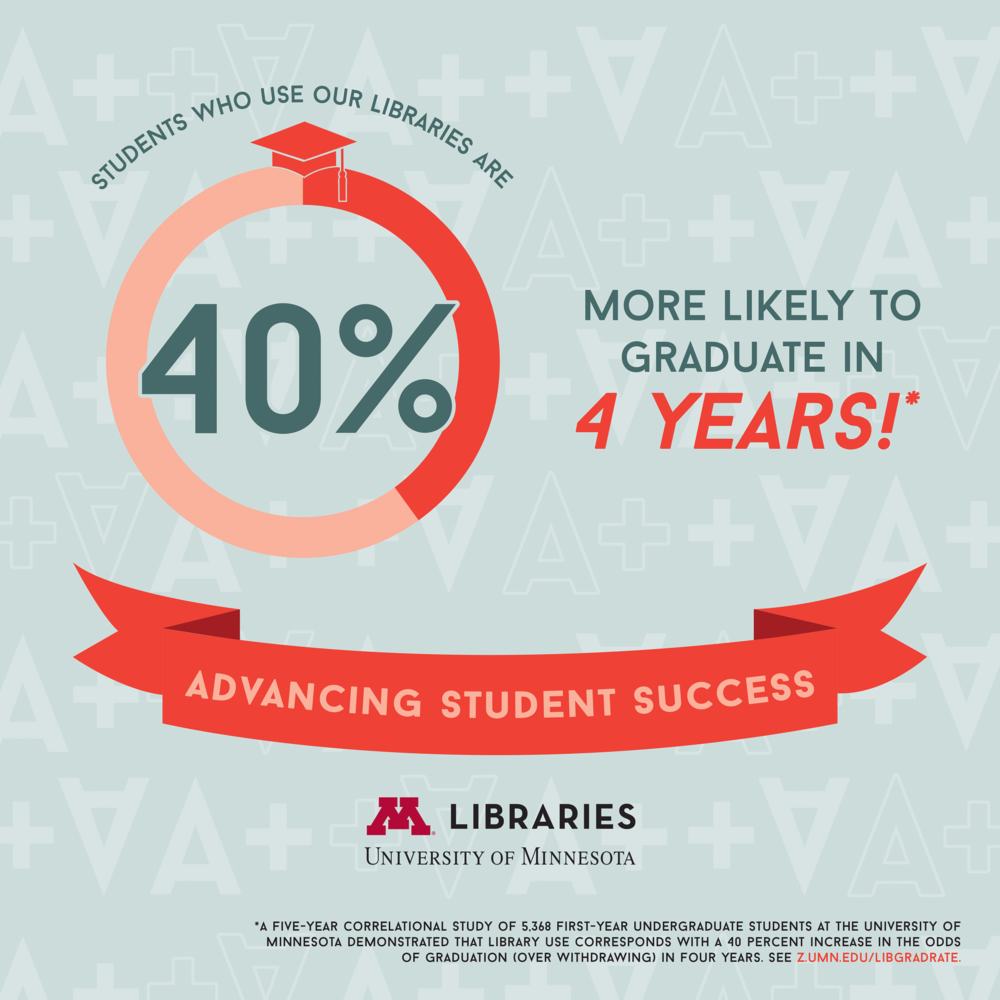By Erin Peterson

At orientation, Undergraduate Services Librarian Kate Peterson talks with incoming students about the value of the Libraries.
Rising sophomore Krista Wigen, a marketing major, expected that she’d sail through the University of Minnesota academically. But then she got her final research assignment for her first-year writing course — a project worth 35 percent of her total grade — and she worried that she was in over her head.
The assignment required her to dig deep into the details of the 1922 Hall-Mills murder case, which was believed to inspire part of The Great Gatsby. “I was used to not having to ask for help for a class in high school,” Wigen says. “But I knew I had to do well on this assignment.”
Fortunately, she also knew she had options. She’d taken a Libraries tour not long after she’d arrived at the U, and she’d learned about Peer Research Consultants (PRCs) at several University libraries. These students — trained specifically to provide research help to fellow U of M undergrads — were available for one-on-one consultations for projects exactly like Wigen’s.
Wigen gathered her courage and went to Walter Library to speak with senior Akshina Banerjee, one of the University’s PRCs. Banerjee helped Wigen brainstorm thesis ideas and track down relevant 1920s newspaper articles. Wigen aced the paper, and says Banerjee was crucial to her success.
“I was hesitant to see a Peer Research Consultant at first, but I’m so glad I did,” she says. “It was so helpful.”
 Wigen’s experience isn’t unusual. According to a study conducted by the University of Minnesota Library Data and Student Success Group, students who use the Libraries at least once during their first year are 40 percent more likely to graduate in four years than their peers who don’t visit the Libraries. That stunning statistic held even after controlling for other factors linked to student success, such as whether the students were eligible for Pell Grants or lived in the residence halls. (All data were de-identified.)
Wigen’s experience isn’t unusual. According to a study conducted by the University of Minnesota Library Data and Student Success Group, students who use the Libraries at least once during their first year are 40 percent more likely to graduate in four years than their peers who don’t visit the Libraries. That stunning statistic held even after controlling for other factors linked to student success, such as whether the students were eligible for Pell Grants or lived in the residence halls. (All data were de-identified.)
The study, which has tracked library use for more than 5,000 students since 2011, examined an array of different categories, such as checking out physical or electronic books, logging into library computer workstations, and meeting with a librarian.
There may be even more good news on the horizon. Researchers soon will have the data for 2017 graduates, which they’ll use to track six-year graduation rates for the 2011 cohort of first-year students. Early indicators suggest the results will be compelling: at the four-year mark, library users were more likely than non-users to have remained enrolled, even if they hadn’t yet graduated.
For Undergraduate Services Librarian Kate Peterson, the numbers are heartening. While she is careful to note that it is hard to prove that library visits led directly to higher graduation rates — correlation is not causation, as statisticians like to say — the best data that the Libraries can collect suggest they’re making a difference.
“Like any other place on campus, libraries are asked to prove their impact,” she says. “It’s not enough to say that a university must have libraries. It’s time for us to say, ‘Here is our real effect on student success.’”
So far, so good. But what is it about libraries that gives student users an edge? We dug into the myriad services and support offered to undergraduates by the Libraries to find out what factors help lead students so efficiently to their diplomas.
Support to get to the finish line
Getting an undergraduate degree is a marathon, not a sprint. And it turns out that preparing for a 26.2-mile race might just be the right analogy for the role that the Libraries plays in that process. For example, while it’s technically true that anyone with a pair of running shoes can make it to a marathon finish line, someone who also has access to a gym full of equipment, a training plan, and a coach is far more likely to succeed. The same is true for students who use the Libraries as part of their academic plan. A student with only a laptop and an internet connection might be able to graduate, like that runner with a pair of sneakers. But library support and resources can help make the journey a far more successful one.
Librarians often find that their first job is to teach students how to navigate the internet more effectively. Even though today’s undergrads have grown up on the web, they still typically need to strengthen their critical thinking skills to separate good information from bad, says Claire Stewart, Associate University Librarian for Research and Learning.
“We have a deluge of information today, but students are actually less well equipped now than they used to be to deal with it,” says Stewart. “Years ago, most of what students were encountering was high quality information that had been preselected for them. That’s not true today.”
In other words, librarians help students unlearn their worst internet habits. “You actually can’t Google everything,” says Stewart. “In fact, the best and most high-quality information is usually the stuff that’s behind paywalls.”
That’s one of the many ways that the Libraries is essential for students: it maintains subscriptions to thousands of (often expensive) journals and databases that provide information that students can access in no other way.
Librarians also help students understand and develop critical thinking skills. For example, librarians frequently give talks to classes about scholarly research, finding sources, and evaluating information. They help students ask the right questions to determine whether the information they’re collecting and using is accurate and authoritative. Does the author have credentials, for example? Are data provided? Was the article peer reviewed by other researchers?
These presentations can feel like a firehose of information for some students. That’s why U librarians have developed and organized interactive online tutorials on the Libraries web page that cover each of these topics — and others — in depth. The goal, says Instructional Designer Lindsay Matts-Benson, is to give students the resources they need right when they need them.
“Not all students have encountered scholarly research articles or scientific studies before, but understanding how they’re organized and what to look for in these [documents] are core skills that students need to develop,” she says. “These tutorials are a way for students to learn new skills, or just refresh them.”
And while librarians may be teaching these research skills to help students succeed in a specific class, the skills themselves — choosing a research subject, understanding citation use, and using databases — are rarely course-specific. Students can take what they’ve learned and apply the key concepts over and over again in classes throughout their academic career — and even beyond the classroom.
“There are all sorts of non-traditional news sources these days, and [many charges of] fake news,” Matts-Benson says. “Understanding how to get credible information is necessary for students in their everyday lives.”
Perfectly tailored space and support
When undergraduates arrive at the University, their preparation for the rigors of University-level work varies. That’s why the Libraries has come up with an array of different services to support students at whatever level they need. Sometimes, that’s simply providing an easy-to-follow calendar for research project scheduling. Sometimes, it’s helping students do some of the heavy lifting as they develop a final project in their major.
Early in undergraduates’ academic careers, for example, time management is often a particularly thorny issue. To help students map out their schedule, the Libraries offers a web-based assignment calculator to plan the process of developing a speech, a research paper, a lab report, or video project. The calculator uses the student-provided deadlines to provide a personalized calendar, complete with the percentage of time to spend on each step and links to helpful resources at each stage of the process.
The library spaces themselves are designed to help students maximize their time. While most schools keep tutoring and academic support services in their own buildings, the University has chosen a distinctive and highly successful model that integrates many of these support services into the Libraries, says LeeAnn Melin, Assistant Dean of Undergraduate Education.
For example, The SMART Learning Commons — physical spaces at Walter, Wilson, and Magrath Libraries — offer peer tutoring and support, including the Peer Research Consultant support that helped Wigen with her Gatsby-based paper. They provide “exam jams” for pre-final studying for specific courses and additional test preparation resources. Melin says keeping these resources in one place makes perfect sense for students.
“When you can make the experience for students seamless — when spaces are approachable, when students can get the help they need right when and where they need it — it helps them do their best work,” she says.
Even students who generally do their studying elsewhere find that libraries play an important role during the final weeks of a term. “During finals, the libraries are open 24 hours a day — they have private study spaces, they have group study spaces, they have coffee,” says Melin. “Students can be there and focus on their learning and not have to worry about anything else that might distract them.”
And when students need help from a real pro? Librarians are around to help with nearly any question a student might have. They have plenty of drop-in hours, and for even more robust support, students can fill out an online form with their exact needs and schedule a time to go deep into a research topic with a librarian.
Just one of these services can help a student get the good grade they need on a paper or a test. Combined, they can be the engine that helps propel a student to commencement — and succeed beyond it.
Looking ahead
Librarians are eager to sift through the next batch of data from the study; it’s likely to show that they’re on the right track. But in the meantime, they’re hard at work to find the best possible ways to support undergraduates as they move through their education.
For example, libraries are looking to strengthen the data collection on the tutoring programs they currently run to ensure that the help students are getting is making an impact. They hope to find ways to use the data they collect to nudge students to get to the library when it’s most useful to them, like during the planning stages of a research paper.
And while much of the work they’re focused on is about helping students succeed in a class or graduate on time, the real benefits go beyond these things. They teach students how to learn, think critically, and ask the right people for help when they need it. Those skills don’t just benefit students during their university years. They benefit them for a lifetime.




